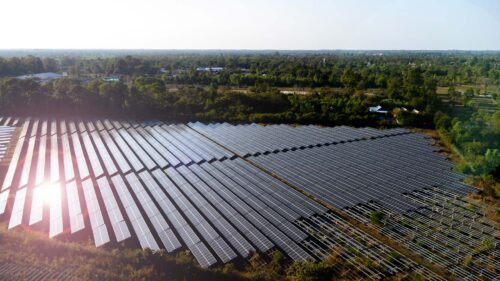
Utilities Need Investments to Decarbonize — Investors Need Accountability
Engage & Act, RMI's new climate insights and data platform, is the tool to make this a match.
A prior version of this blog was published in April 2023.
Electric utilities: Energy transition drivers
Despite increasing amounts of renewable power generation coming online, the US electricity sector is still incredibly carbon-intensive, accounting for nearly one-third of total U.S. CO2e emissions. Reducing utility carbon emissions is necessary to reach global climate goals, especially as other sectors, like buildings and transportation, electrify and rely more heavily on electric utilities.
In fact, RMI modeling shows electrification of the US economy will approximately double electricity demand from 2025-2035. We will need to simultaneously reduce CO2e emissions by 80 percent while we build out somewhere between six to nine times the renewable capacity we have today. To build out the clean energy resources necessary to pivot away from fossil electricity generation while increasing electricity supply, and without compromising reliability or burdening ratepayers, the utility sector will need significant capital investment — RMI estimates the opportunity to electrify the US economy is valued at $1.3 trillion by 2030.
Exhibit 1: Historic and projected U.S. electricity generation by energy source
Today, coal and gas are still core components of existing utility power generation fleets. Though some utilities have submitted integrated resource plans (IRPs) to their regulators that demonstrate progress towards climate alignment with planned capital expenditures in clean generation, most are not moving quickly enough to align with a 1.5°C pathway. In addition to providing the capital required to build the clean, renewable power generation and grid infrastructure needed for a successful transition, stakeholders – including investors, regulators, advocates, and others – must also engage with utilities to ensure capital is directed towards these climate-aligned solutions. This is a critical time for utilities, as the opportunity of rapid load growth from sources such as data centers and electric vehicle charging, combined reliability concerns, interconnection delays, and other challenges, could be contributing to some utilities pushing out previously announced coal retirement dates or building new gas plants.
The electricity sector needs to reduce emissions by 80 percent by 2035 to be climate-aligned. While most investor-owned utilities have publicly stated emissions reduction targets, they are not ambitious enough, and progress on commitments to date has been lackluster. In aggregate, utility decarbonization targets, if achieved, will reduce emissions by just 50 percent. But achieving those targets is not likely based on utilities’ capex plans. Pressure and informed engagement from stakeholders can be the key that bends the curve to a stable future. Fortunately, the US electric utility sector is uniquely positioned for this approach by offering clear decarbonization pathways, relatively rich data, and business models that rely on funding from capital markets.
With the right metrics and engagement support, climate-conscious stakeholders can contribute to both sufficient capital allocation and needed accountability for utilities to cut carbon emissions in line with limiting global warming to 1.5°C above pre-industrial levels. RMI has developed a platform, Engage & Act, to help a variety of stakeholders become a conduit for utility transition at scale.
Forward-looking, capex-based metrics will help inform engagement for change
To thoughtfully engage in a way that is truly aligned with a clean energy future, stakeholders need to look into the future. While using company targets to assess future progress can offer some initial insights, RMI analysis has found that, given utilities’ current capex plans, targets are both not climate-aligned and unlikely to be achieved.
Exhibit 2
Stakeholders can use capex data, along with past production data, to assess historical and projected emissions for electric utilities in their portfolio, or to evaluate and select new investment opportunities. However, it’s not easy to produce good electric utility data. Electric utilities report a variety of information to a host of government agencies and organizations at different levels of complexity. While it may seem straightforward, obtaining a clear picture of a single electric utility using only one data source is not possible. Even when drawing on multiple data sources, the data cleaning process can be difficult and time consuming. Doing this for the entire electric utility sector is a monumental task.
RMI’s Engage & Act platform is designed to support stakeholders with the heavy lifting around electric utility data aggregation, cleaning, and analysis. This empowers more informed decisions about how to engage with electric utilities and where to deploy capital to have the greatest impact on the power sector. The platform offers:
- A unique data set on electric utilities that breaks down how each utility’s decarbonization targets and capex plans compare to a 1.5°C-aligned emissions trajectory through 2050.
- RMI-authored thought leadership on the electric utility sector.
- Engagement support for stakeholders, including one-on-one meetings with RMI electric utility experts, utility capex and emissions analysis, and more.
- Accountability metrics to track progress towards decarbonization.
Electric utilities should be a primary subject of engagement and investment precisely because they are significant carbon-emitters. Electric-utility-specific data and metrics can equip stakeholders for productive engagements that steer electric utilities towards investing in the best possible climate outcomes and help hold them accountable for reaching their climate goals.
RMI is actively seeking early users of Engage & Act data and offerings. To learn more, please visit our website or contact us using this form.